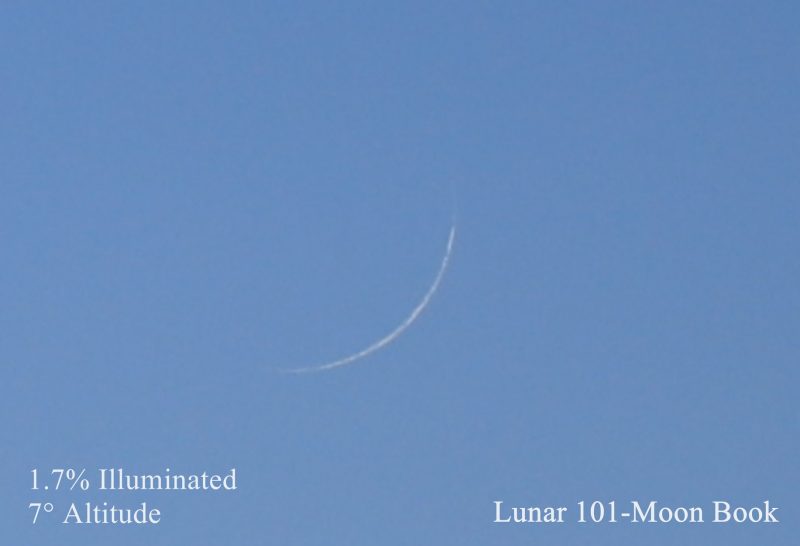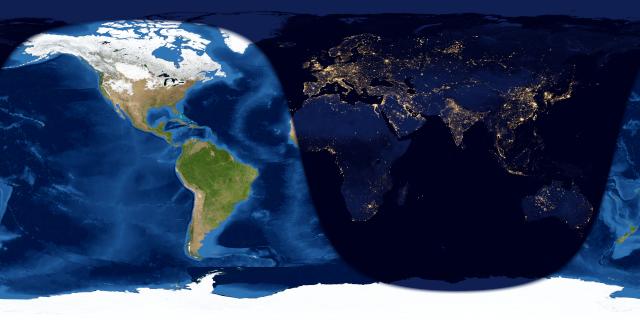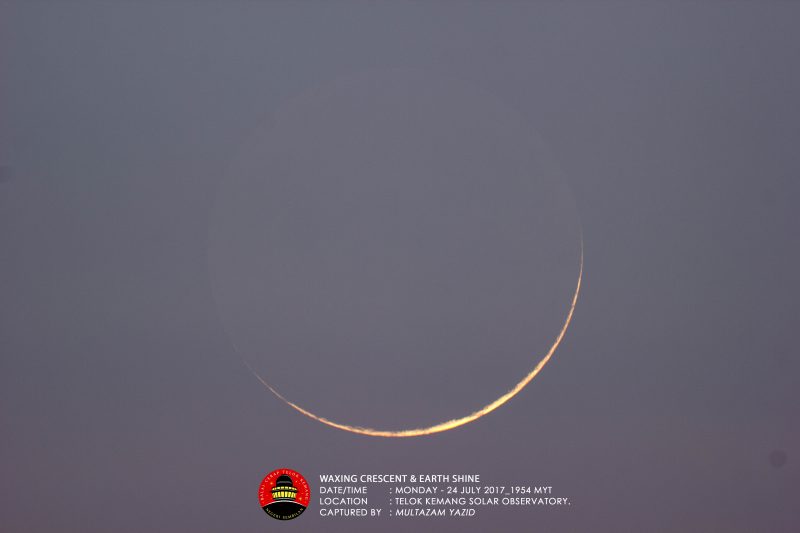You might – or might not – catch the youngest and slenderest of young moons, with either the eye alone or binoculars, after sunset February 12, 2021. Find an unobstructed horizon in the direction of sunset and look low in the west as evening dusk is ebbing toward nightfall. If you miss the young moon on February 12, try the next several evenings, February 13 to 15, for example. Day by day, a wider waxing crescent moon will be higher up in the west at sunset, and will stay out longer after sundown.
Generally, it’s difficult to spot a moon less than one day old, or less than 24 hours after new moon. But for every day after that, as the moon moves toward the east in its orbit around Earth, its distance from the sun in our sky increases. And so we see a larger portion of the moon’s day side, staying out longer after sunset.

The moon turned new on February 11, 2021, at 19:05 UTC. At new moon, the moon more or less rises and sets with the sun, with its dark side facing Earth and its illuminated side facing the sun. Little wonder why the moon is invisible on the day of the new moon (unless there’s a solar eclipse, when the new moon sweeps directly in front of the sun).
Still, some people around the world might spot the tiniest sliver of lunar crescent after sunset on February 12, 2021. The farthest west you are from Earth’s International Date Line, the more likely it is you’ll be able to spot it. In other words, North or South America, for instance, or islands in the Pacific, have a better shot at catching the young moon than Asia on February 12.
At U.S. time zones, the new moon occurred on February 11 at 2:05 p.m. EST, 1:05 p.m. CST, 12:05 p.m. MST and 11:05 a.m. PST. So the moon will be older than one day old as the sun sets on North America on February 12, 2021. Given a clear sky and an unobstructed horizon in the direction of sunset, folks in North America should be able to spot the thin lunar crescent after sunset February 12.
At mid-northern latitudes in North America, the moon will set about one hour after the sun on February 12.
If you live in the world’s Eastern Hemisphere – Europe, Africa, Asia, Australia and New Zealand – the moon will be less than 24 hours old at sunset February 12. That’s not to say some eagle-eyed young moon aficionados won’t spot the barely perceptible crescent all but bleached out in the glow of evening twilight. But it won’t be easy!
Live in the U.S. or Canada? Click on Old Farmer’s Almanac to know when the moon sets in your sky.
For virtually anywhere worldwide, consult TimeandDate for the moon’s setting time in your sky.


On February 13, 14 and 15, 2021, it’s a different story. No matter where you live, watch for the increasingly older young moon to stay out longer after dark on those dates. Notice the moon’s dark or nighttime side basking in a pale glow. This glow is wondrous earthshine, or twice-reflected sunlight, that is, sunlight that has bounced off Earth to the moon, and back.
Bottom line: A young moon is easy to miss. The faint and skinny lunar crescent lurks low in the sky at sunset; and soon thereafter, the young moon follows the sun beneath the horizon, to disappear before evening dusk totally gives way to nightfall. The February 12, 2021, young moon won’t be easy. But afterwards – on February 13, 14 and 15 – you’ll find the waxing crescent in your western twilight sky.











